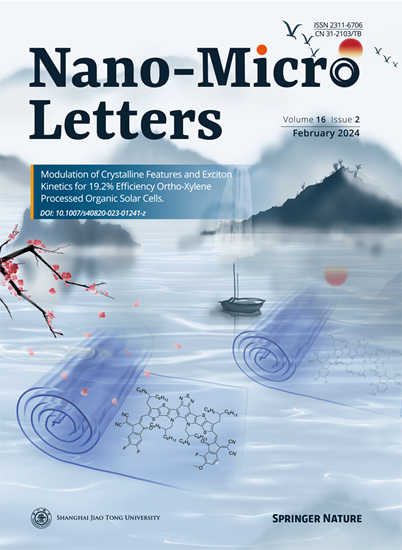Scalable Fabrication of Methylammonium-Free Wide-Bandgap Perovskite Solar Cells by Blade Coating in Ambient Air
IF 36.3
1区 材料科学
Q1 Engineering
引用次数: 0
Abstract
Highlights
-
RbI is the most effective in mitigate PbI2 precipitation caused by Pb(SCN)2 while maintaining large grains.
-
Rb is kept at the grain boundaries during crystallization and Ostwald ripening, contributes to a slow growth of the grains.
-
Wide-bandgap perovskite solar cells with blade-coated perovskite in air achieved a certified power conversion efficiency of 23%, among the highest values reported.
无甲铵宽禁带钙钛矿太阳能电池的叶片涂层可扩展制备。
高效宽带隙钙钛矿太阳能电池(PSCs)的可扩展制造是实现串联太阳能电池全部商业潜力的关键。然而,利用叶片涂层技术制备高效的无甲基铵(MA-free) WBG PSCs存在诸多挑战,特别是其相分离性和膜稳定性。本文研制了一种不含ma的WBG钙钛矿油墨,用于在环境空气中进行叶片涂布制备FA0.8Cs0.2Pb(I0.75Br0.25)3薄膜。在各种a位碘化物中,RbI对Pb(SCN)2诱导的PbI2析出抑制效果最好,同时保持了晶粒的扩大。Rb的分布表明,在结晶和奥斯特瓦尔德成熟过程中,Rb离子与钙钛矿颗粒保持隔离,这有助于以最小的非辐射复合形成大颗粒WBG钙钛矿膜。结果,在小面积WBG PSCs上实现了23.0%的功率转换效率(PCE),而孔径面积为10.5 cm2的微型组件的PCE为20.2%,是通过叶片涂层由WBG钙钛矿制备的太阳能电池中最高的。这项工作提出了一种在环境条件下稳定的无ma WBG psc的可扩展和可重复的制造策略,推进了其商业化的道路。
本文章由计算机程序翻译,如有差异,请以英文原文为准。
求助全文
约1分钟内获得全文
求助全文
来源期刊

Nano-Micro Letters
NANOSCIENCE & NANOTECHNOLOGY-MATERIALS SCIENCE, MULTIDISCIPLINARY
CiteScore
32.60
自引率
4.90%
发文量
981
审稿时长
1.1 months
期刊介绍:
Nano-Micro Letters is a peer-reviewed, international, interdisciplinary, and open-access journal published under the SpringerOpen brand.
Nano-Micro Letters focuses on the science, experiments, engineering, technologies, and applications of nano- or microscale structures and systems in various fields such as physics, chemistry, biology, material science, and pharmacy.It also explores the expanding interfaces between these fields.
Nano-Micro Letters particularly emphasizes the bottom-up approach in the length scale from nano to micro. This approach is crucial for achieving industrial applications in nanotechnology, as it involves the assembly, modification, and control of nanostructures on a microscale.
 求助内容:
求助内容: 应助结果提醒方式:
应助结果提醒方式:


